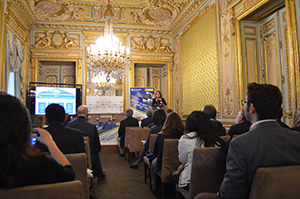Parallel Session 1.1: Advancing Desalination: reducing energy consumption and the environmental footprint
November 14th, 16:00 – 17:30
Session Chair: Mr Kalanithy Vairavamoorthy, Executive Director, International Water Association (IWA)
Session Speakers:
- Mr Antonio Borrero, Director, Africa and Europe, Water Deparment, Abengoa, Spain
- Mr Nicholas Sloane, Director, Resolve Marine Group, Cape Town, South Africa
- Mr Nikolay Voutchkov, DTRI and Saline Water Conversion Cooperation, Saudi Arabia
- Mr Domingo Zarzo Martínez, Technical and Innovation Manager, SACYR Water Services, Spain
- Ms Dionysia Lyra, International Centre on Biosaline Agriculture (ICBA), United Arab Emirates
Session Summary

With over 16,000 desalination plants and 100 million cubic meters per day of fresh water production, desalination has become a widely used technology for municipal water supply in coastal communities of the Middle East, Southern Europe, the US and Australia.
The main challenges currently faced by the technology are its associated energy cost and the environmental impacts from brine. The cost is much influenced by productivity and the energy cost (40-60 percent of the cost of the plant), which is decreasing through the development and upscaling of renewable energy. Although, the cost of desalinated water production may be still high, it is an important alternative and additional source of water to address global water scarcity.
Spain is a pioneer in the use of desalinated water for agriculture. Many crops can support the cost of desalinated water without a significant impact on the overall product price. Integrated agri-aquaculture farms promoted by ICBA are also testing the integration of saline water sources into the farms also with the use of salt-tolerant crops. In addition, iceberg towing from Antarctica to South Africa has been presented as a feasible solution for proving drinking water to the city of Cape Town.
Key take home points from each speaker:
Mr Antonio Borrero described a new initiative to provide desalinated water to farmers in Morocco. Abengoa, is an international company that applies innovative technology solutions for sustainability in the infrastructures, energy and water sectors. The company is one of the largest builders of desalination facilities globally and it is part of a public-private partnership in Morocco to build a coastal desalination facility near the town of Agadir in the Chtouka Ait Baha Province. Roughly, half of the water will supply domestic users and half will go to farmers. Farmers accounted for about 2 percent of the financial investment with the rest going to governmental agencies and the private sector. Several speakers pointed out that use of desalinated water for agriculture is cost-effective for high value crops

Mr Nicholas Sloane presented the work of Resolve Marine Group in South Africa, which is developing the iceberg towing technology. 2000 billion tons of ice falls from icebergs each year and the studies to develop the technology of iceberg towing started more than 30 years ago. The plan is being proposed as a solution to the decreasing water resources in Cape Town and utilizes the ocean current in minimizing fuel cost in towing the iceberg.
Mr Nikolay Voutchkov presented an overview of state-of-the-art technologies in the water desalination industry. There are currently 16,000 desalination plants worldwide delivering ~ 100M m3/day of water to satisfy 5 percent of the world’s population. Energy and financial costs of desalination have come down over the past 10 years. Reverse osmosis technology now dominates over thermal desalination. According to Mr Voutchkov, bigger is better - large-scale desalination plants are much more efficient. As of 2019, large plants can deliver water at $0.6 - $0.9/m3 consuming between 2.8 – 3.2 kWh/m³. Thermal desalination is being phased out with no new plants being built, which is seen as positive given that this technology is less efficient and has a larger environmental footprint (i.e. thermal pollution to the ocean).

Mr Domingo Zarzo Works at Sacyr Agua, which uses a water cycle management approach. The company is making efforts to to bring desalinated water to inland farms in Spain. He noted that only 2-3 percent of desalinated water is currently being used for agriculture. However, in Spain, higher precentages (23 percent) of desalinated water are going to agriculture. He described several plants in Spain as examples.
Ms. Dionysia Lyra’s from ICBA based in the United Arab Emirates, discussed the center’s initiative to develop modular farms (fish, vegetables, halophile grasses, and livestock). What is novel about this system is that the intake of water to farms is brackish. The water is desalinated before being used for farming. A big focus of ICBA’s modular farms is to find synergistic interactions between each module. For example, waste products from one part of the system (e.g. waste effluent from fish farming) is used by another parts of the system (e.g. fertilizer for crops). However, the use of salt tolerant grass and desalination of brackish waters sets this endeavor apart. Several pilot projects around the Middle East using this technology were discussed. Finding markets for salt tolerant grass was one of the future goals.

